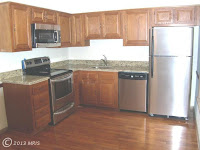Before we were married, my husband acquired a tray table. This tray table somehow made every move and often found itself right next to his lazy boy, dutifully holding his lap top and drink. Eventually we found a better side table and this tray table's days were numbered. I just hate tossing something that is not broken and we did need a table upstairs so I decided to save it. But this table needed a new look.
 This will not be an "every day" table. Just an extra side table for entertaining.
This will not be an "every day" table. Just an extra side table for entertaining.
I sanded the table down, then washed it. I like a clean, smooth surface when painting.
Flipped it upside down and sprayed it with primer. Flipped it right side up and primed the top and edges.
Once the primer had fully dried, I prepped the top of the table for painting.
I taped off the edges and used a 1 inch brush to paint along each side.
I used a foam roller to fill in the rest.
Foam rollers are a great alternative to brushes, especially if you are painting wood and do not want the grain to show through.
~ An important message regarding painter's tape ~
I use painter's tape often but it took me one time of tearing off the majority of the fresh paint I had put on our crown molding to realize how patient you have to be when using it. Now, when paint is dried, I slowly tear it off in a downward diagonal motion (see picture above). This has saved a lot of heartache and unfortunate language being shouted.
~ Now on to stenciling ~
This was the first time I used stencil adhesive and I've been wondering where it has been all my life. I dabbed it around the stencil, waited for it to dry, and positioned it where I wanted.
A little paint goes a long way when stenciling. Whether using a foam pouncer or a brush, I always get rid of excess paint and dab the applicator a few times before applying.
As usual I used Martha Stewart's multi-surface craft paint that I bought at Michaels. Besides being able to use it on various surfaces, it can also be mixed with other paints or finishes to get the desired effect you're looking for. For example I used a dark brown (Vanilla Bean) and mixed it with a glitter paint (Smokey Quartz) to paint one of the branches.
When the stenciling was finished and all the paint was dry, I took the table outside and sprayed it with sealant.
A little craft paint and some stencils can take an old (random) tray table and turn it into a decent side table for drinks & appetizers.
~ B






































